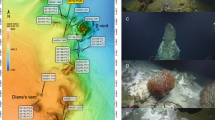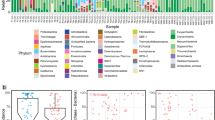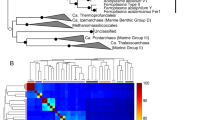Abstract
The discovery of archaeal lineages is critical to our understanding of the universal tree of life and evolutionary history of the Earth. Geochemically diverse thermal environments in Yellowstone National Park provide unprecedented opportunities for studying archaea in habitats that may represent analogues of early Earth. Here, we report the discovery and characterization of a phylum-level archaeal lineage proposed and herein referred to as the ‘Marsarchaeota’, after the red planet. The Marsarchaeota contains at least two major subgroups prevalent in acidic, microaerobic geothermal Fe(III) oxide microbial mats across a temperature range from ~50–80 °C. Metagenomics, single-cell sequencing, enrichment culturing and in situ transcriptional analyses reveal their biogeochemical role as facultative aerobic chemoorganotrophs that may also mediate the reduction of Fe(III). Phylogenomic analyses of replicate assemblies corresponding to two groups of Marsarchaeota indicate that they branch between the Crenarchaeota and all other major archaeal lineages. Transcriptomic analyses of several Fe(III) oxide mat communities reveal that these organisms were actively transcribing two different terminal oxidase complexes in situ and genes comprising an F420-dependent butanal catabolism. The broad distribution of Marsarchaeota in geothermal, microaerobic Fe(III) oxide mats suggests that similar habitat types probably played an important role in the evolution of archaea.
This is a preview of subscription content, access via your institution
Access options
Access Nature and 54 other Nature Portfolio journals
Get Nature+, our best-value online-access subscription
$29.99 / 30 days
cancel any time
Subscribe to this journal
Receive 12 digital issues and online access to articles
$119.00 per year
only $9.92 per issue
Buy this article
- Purchase on Springer Link
- Instant access to full article PDF
Prices may be subject to local taxes which are calculated during checkout




Similar content being viewed by others
References
Nunoura, T. et al. Insights into the evolution of archaea and eukaryotic protein modifier systems revealed by the genome of a novel archaeal group. Nucleic Acids Res. 39, 3204–3223 (2011).
Inskeep, W. P. et al. Phylogenetic and functional analysis of metagenome sequence from high-temperature archaeal habitats demonstrate linkages between metabolic potential and geochemistry.Front. Microbiol. 4, 95 (2013).
Kozubal, M. A. et al. Geoarchaeota: a new candidate phylum in the archaea from high-temperature acidic iron mats in Yellowstone National Park. ISME J. 7, 622–634 (2013).
Rinke, C. et al. Insights into the phylogeny and coding potential of microbial dark matter. Nature 499, 431–437 (2013).
Castelle, C. J. et al. Genomic expansion of domain archaea highlights roles for organisms from new phyla in anaerobic carbon cycling. Curr. Biol. 25, 690–701 (2015).
Spang, A. et al. Complex archaea that bridge the gap between prokaryotes and eukaryotes. Nature 521, 173–179 (2015).
Vanwonterghem, I. et al. Methylotrophic methanogenesis discovered in the archaeal phylum Verstraetearchaeota. Nat. Microbiol. 1, 16170 (2016).
Zaremba-Niedzwiedzka, K. et al. Asgard archaea illuminate the origin of eukaryotic cellular complexity. Nature 541, 353–358 (2017).
Forterre, P. The universal tree of life: an update.Front. Microbiol. 6, 717 (2015).
Hug, L. A. et al. A new view of the tree of life. Nat. Microbiol. 1, 16048 (2016).
Woese, C. R., Kandler, O. & Wheelis, M. L. Towards a natural system of organisms: proposal for the domains archaea, bacteria, and eucarya. Proc. Natl Acad. Sci. USA 87, 4576–4579 (1990).
Forterre, P. The common ancestor of archaea and eukarya was not an archaeon. Archaea 2013, e372396 (2013).
Raymann, K., Forterre, P., Brochier-Armanet, C. & Gribaldo, S. Global phylogenomic analysis disentangles the complex evolutionary history of DNA replication in archaea. Genome Biol. Evol. 6, 192–212 (2014).
Da Cunha, V., Gaia, M., Gadelle, D., Nasir, A. & Forterre, P. Lokiarchaea are close relatives of Euryarchaeota, not bridging the gap between prokaryotes and eukaryotes. PLoS Genet. 13, e1006810 (2017).
Beam, J. P. et al. Assembly and succession of iron oxide microbial mat communities in acidic geothermal springs.Front. Microbiol. 7, 25 (2016).
Inskeep, W. P. et al. Metagenomes from high-temperature chemotrophic systems reveal geochemical controls on microbial community structure and function. PLoS ONE 5, e9773 (2010).
Jay, Z. J. et al. The distribution, diversity and function of predominant Thermoproteales in high-temperature environments of Yellowstone National Park. Environ. Microbiol. 18, 4755–4769 (2016).
Beam, J. P., Jay, Z. J., Kozubal, M. A. & Inskeep, W. P. Niche specialization of novel Thaumarchaeota to oxic and hypoxic acidic geothermal springs of Yellowstone National Park. ISME J. 8, 938–951 (2014).
Kozubal, M. A. et al. Microbial iron cycling in acidic geothermal springs of Yellowstone National Park: integrating molecular surveys, geochemical processes, and isolation of novel Fe-active microorganisms. Front. Microbiol. 3, 109 (2012).
Konstantinidis, K. T. & Tiedje, J. M. Towards a genome-based taxonomy for prokaryotes. J. Bacteriol. 187, 6258–6264 (2005).
Brochier-Armanet, C., Gribaldo, S. & Forterre, P. A DNA topoisomerase IB in Thaumarchaeota testifies for the presence of this enzyme in the last common ancestor of archaea and eucarya. Biol. Direct 3, 54 (2008).
Dahmane, N. et al. topIb, a phylogenetic hallmark gene of Thaumarchaeota encodes a functional eukaryote-like topoisomerase IB. Nucleic Acids Res. 44, 2795–2805 (2016).
Ney, B. et al. The methanogenic redox cofactor F420 is widely synthesized by aerobic soil bacteria. ISME J. 11, 125–137 (2017).
Cook, A. M., Smits, T. H. M. & Denger, K. in Microbial Sulfur Metabolism (eds Dahl, C. & Friedrich, C. G.) 170–183 (Springer, Berlin, Heidelberg, 2008).
Müller, F. H. et al. Coupling of the pathway of sulphur oxidation to dioxygen reduction: characterization of a novel membrane-bound thiosulphate:quinone oxidoreductase. Mol. Microbiol. 53, 1147–1160 (2004).
Kozubal, M. A., Dlakić, M., Macur, R. E. & Inskeep, W. P. Terminal oxidase diversity and function in “Metallosphaera yellowstonensis”: gene expression and protein modeling suggest mechanisms of Fe(II)-oxidation in the Sulfolobales. Appl. Environ. Microbiol. 77, 1844–1853 (2011).
Castelle, C. J. et al. The aerobic respiratory chain of the acidophilic archaeon Ferroplasma acidiphilum: a membrane-bound complex oxidizing ferrous iron. Biochim. Biophys. Acta 1847, 717–728 (2015).
David, L. A. & Alm, E. J.Rapid evolutionary innovation during an archaean genetic expansion. Nature 469, 93–96 (2010).
Stolper, D. A., Revsbech, N. P. & Canfield, D. E. Aerobic growth at nanomolar oxygen concentrations. Proc. Natl Acad. Sci. USA 107, 18755–18760 (2010).
Dobbek, H., Gremer, L., Kiefersauer, R., Huber, R. & Meyer, O. Catalysis at a dinuclear [CuSMo(O)OH] cluster in a CO dehydrogenase resolved at 1.1-Å resolution. Proc. Natl Acad. Sci. USA 99, 15971–15976 (2002).
Bell, J. F., McCord, T. B. & Owensby, P. D. Observational evidence of crystalline iron oxides on Mars. J. Geophys. Res. Solid Earth 95, 14447–14461 (1990).
Morris, R. V. et al. Mineralogy, composition, and alteration of Mars Pathfinder rocks and soils: evidence from multispectral, elemental, and magnetic data on terrestrial analogue, SNC meteorite, and Pathfinder samples. J. Geophys. Res. Planets 105, 1757–1817 (2000).
Vargas, M., Kashefi, K., Blunt-Harris, E. L. & Lovley, D. R. Microbiological evidence for Fe(III) reduction on early Earth. Nature 395, 65–67 (1998).
Nisbet, E. G. & Sleep, N. H. The habitat and nature of early life. Nature 409, 1083–1091 (2001).
Chen, I.-M. A. et al. IMG/M: integrated genome and metagenome comparative data analysis system. Nucleic Acids Res. 45, D507–D516 (2017).
Van der Maaten, L. & Hinton, G. Visualizing data using t-SNE. J. Mach. Learn. Res. 9, 2579–2605 (2008).
Hahsler, M., Piekenbrock, M., Arya, S. & Mount, D. Package ‘dbscan’: Density Based Clustering of Applications with Noise (DBSCAN) and Related Algorithms (CRAN, 2016).
Eddy, S. R. Accelerated profile HMM searches. PLoS Comput. Biol. 7, e1002195 (2011).
Katoh, K. & Standley, D. M. MAFFT multiple sequence alignment software version 7: improvements in performance and usability. Mol. Biol. Evol. 30, 772–780 (2013).
Capella-Gutiérrez, S., Silla-Martínez, J. M. & Gabaldón, T. trimAl: a tool for automated alignment trimming in large-scale phylogenetic analyses. Bioinformatics 25, 1972–1973 (2009).
Ronquist, F. et al. MrBayes 3.2: efficient Bayesian phylogenetic inference and model choice across a large model space. Syst. Biol. 61, 539–542 (2012).
Nawrocki, E. Structural RNA Homology Search and Alignment Using Covariance Models PhD thesis, Washington Univ. (2009).
Camacho, C. et al. BLAST+: architecture and applications. BMC Bioinformatics 10, 421 (2009).
Richter, M. & Rosselló-Móra, R. Shifting the genomic gold standard for the prokaryotic species definition. Proc. Natl Acad. Sci. USA 106, 19126–19131 (2009).
Stoecker, K., Dorninger, C., Daims, H. & Wagner, M. Double labeling of oligonucleotide probes for fluorescence in situ hybridization (DOPE-FISH) improves signal intensity and increases rRNA accessibility. Appl. Environ. Microbiol. 76, 922–926 (2010).
Seemann, T. Prokka: rapid prokaryotic genome annotation. Bioinformatics 30, 2068–2069 (2014).
Bankevich, A. et al. SPAdes: a new genome assembly algorithm and its applications to single-cell sequencing. J. Comput. Biol. 19, 455–477 (2012).
Parks, D. H., Imelfort, M., Skennerton, C. T., Hugenholtz, P. & Tyson, G. W. CheckM: assessing the quality of microbial genomes recovered from isolates, single cells, and metagenomes. Genome Res. 25, 1043–1055 (2015).
Lindås, A.-C., Karlsson, E. A., Lindgren, M. T., Ettema, T. J. G. & Bernander, R. A unique cell division machinery in the archaea. Proc. Natl Acad. Sci. USA 105, 18942–18946 (2008).
Acknowledgements
The authors acknowledge support from the DOE Pacific Northwest National Laboratory (subcontracts 112443 and 254840), DOE Joint Genome Institute Community Sequencing Program (CSP 787081 and CSP 701), National Science Foundation Integrative Graduate Education and Research Traineeship Program (Z.J.J. and J.P.B.) (NSF DGE 0654336) and Montana Agricultural Experiment Station (W.P.I.). Work conducted by the Pacific Northwest National Laboratory (Foundational Scientific Focus Area) and Joint Genome Institute (DOE-AC02-05CH11231) is supported by the Genomic Science Program, Office of Biological and Environmental Research, US DOE. The authors appreciate assistance from S. Tringe, T. Woyke and D. Goudeau for genome and single-cell sequencing at the DOE Joint Genome Institute, C. Carey and A. Mazurie (MSU) for Illumina metagenome and iTag data processing, R. Jennings (MSU) for genome curation, R. Carlson (MSU) for collaboration on metabolic pathway analysis, and C. Hendrix, S. Sigler and D. Hallac (Center for Resources, YNP) for permitting this work in YNP (permits YELL-SCI-5068 and -5686). Computations were performed on the Hyalite High-Performance Computing System, operated and supported by MSU’s Information Technology Center.
Author information
Authors and Affiliations
Contributions
W.P.I., Z.J.J., J.P.B. and M.A.K. designed the study. Z.J.J., J.P.B., M.A.K. and W.P.I. collected and analysed the field data. Z.J.J., M.D. and D.B.R. conducted the informatic analyses. M.D., W.P.I. and J.P.B. conducted the phylogenetic analysis. M.A.K. and J.P.B. established and analysed the enrichment cultures. Z.J.J. and J.P.B analysed the transcriptomic data. J.P.B. and W.P.I. performed microscopy and FISH analysis. W.P.I., M.D., Z.J.J. and J.P.B. wrote the manuscript. All authors reviewed and edited the manuscript.
Corresponding author
Ethics declarations
Competing interests
The authors declare no competing interests.
Additional information
Publisher's note: Springer Nature remains neutral with regard to jurisdictional claims in published maps and institutional affiliations.
Supplementary information
Supplementary Information
Supplementary Figures 1–12, Supplementary References.
Supplementary Table 1
List of different species of either Archaea, Bacteria or Eukarya and 55 proteins used in phylogenomic analyses (this is essentially the same group of proteins).
Supplementary Table 2
Metagenomes (M), transcriptomes (T) and single amplified genomes (SAG) of high-temperature, acidic iron oxide microbial mats from Yellowstone National Park that have been used in the study and description of Marsarchaeota groups 1 and 2. Sequence assemblies are available on IMG/M (DOE-Joint Genome Institute, Walnut Creek, CA).
Supplementary Table 4
Transcriptome reads mapped to annotated genome sequence of Marsarchaeota group 1 (sheet MarsG1-r04) and group 2 (sheet MarsG2-r02) for three Fe(III) oxide microbial mats (RPKM values) from Norris Geyser Basin (YNP).
Rights and permissions
About this article
Cite this article
Jay, Z.J., Beam, J.P., Dlakić, M. et al. Marsarchaeota are an aerobic archaeal lineage abundant in geothermal iron oxide microbial mats. Nat Microbiol 3, 732–740 (2018). https://doi.org/10.1038/s41564-018-0163-1
Received:
Accepted:
Published:
Issue Date:
DOI: https://doi.org/10.1038/s41564-018-0163-1
This article is cited by
-
Diversity and function of methyl-coenzyme M reductase-encoding archaea in Yellowstone hot springs revealed by metagenomics and mesocosm experiments
ISME Communications (2023)
-
Diverse Bathyarchaeotal Lineages Dominate Archaeal Communities in the Acidic Dajiuhu Peatland, Central China
Microbial Ecology (2023)
-
Culexarchaeia, a novel archaeal class of anaerobic generalists inhabiting geothermal environments
ISME Communications (2022)
-
Expanding Asgard members in the domain of Archaea sheds new light on the origin of eukaryotes
Science China Life Sciences (2022)
-
Brockarchaeota, a novel archaeal phylum with unique and versatile carbon cycling pathways
Nature Communications (2021)



